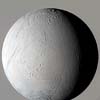| . |  |
. |
The Cassini spacecraft has seen a 50-mile-diameter impact crater on Titan with different instruments on separate flybys, giving scientists new information on impact-crater formation on Saturn's giant moon. They've released a composite image of one of Titan's most prominent impact craters as previously seen by Cassini's radar and recently seen by its Visual and Infrared Mapping Spectrometer (VIMS). The radar image was taken during the Cassini spacecraft's Feb. 15, 2005 Titan flyby, and the VIMS images were taken during its April 16, 2005 Titan flyby, said Robert H. Brown of The University of Arizona, head of the VIMS experiment. Brown released the composite image at the European Geosciences Union meeting in Vienna, Austria, on Monday (April 25). The crater seen on Titan by both radar and VIMS is more than 50 times larger than Meteor Crater in northern Arizona. In radar, the crater and its ejecta blanket are bright. In radar, brighter surfaces mean rougher terrains, or else terrains tilted towards the radar. At VIMS infrared wavelengths, the crater appears dark and the ejecta blanket is bright, showing that the crust on the crater floor is different material than the ejecta. "The composite image highlights the differences and similarities in how two instruments see the same thing," Brown said. "It shows the power of combining instruments when you are trying to understand objects in the Saturnian system." VIMS is essentially a camera that takes pictures in 352 different colors at the same time. The colors cover the visible spectrum and into the infrared, or from three-tenths of a micron up to five and one-tenth microns. (A micron is one millionth of a meter.) Scientists can identify the chemical composition of the surfaces, atmospheres and rings of Saturn and its moons using VIMS. Cassini began a 4-year-or-more exploratory tour of the Saturn system in July 2004. It has seen two impact craters on Titan so far. Related Links SpaceDaily Search SpaceDaily Subscribe To SpaceDaily Express  Pasadena CA (JPL) Apr 26, 2005
Pasadena CA (JPL) Apr 26, 2005The Cassini spacecraft has discovered intriguing dust particles around Saturn's moon Enceladus. The particles might indicate the existence of a dust cloud around Enceladus, or they may have originated from Saturn's outermost ring, the E-ring.
|
| ||||||||||
| The content herein, unless otherwise known to be public domain, are Copyright 1995-2016 - Space Media Network. All websites are published in Australia and are solely subject to Australian law and governed by Fair Use principals for news reporting and research purposes. AFP, UPI and IANS news wire stories are copyright Agence France-Presse, United Press International and Indo-Asia News Service. ESA news reports are copyright European Space Agency. All NASA sourced material is public domain. Additional copyrights may apply in whole or part to other bona fide parties. Advertising does not imply endorsement, agreement or approval of any opinions, statements or information provided by Space Media Network on any Web page published or hosted by Space Media Network. Privacy Statement All images and articles appearing on Space Media Network have been edited or digitally altered in some way. Any requests to remove copyright material will be acted upon in a timely and appropriate manner. Any attempt to extort money from Space Media Network will be ignored and reported to Australian Law Enforcement Agencies as a potential case of financial fraud involving the use of a telephonic carriage device or postal service. |